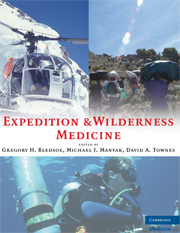Book contents
- Frontmatter
- Contents
- Contributors
- Foreword
- Preface
- Acknowledgments
- PART I EXPEDITION PLANNING
- 1 The Expedition Physician
- 2 Assessing Expedition Medical Needs
- 3 Expedition Medical Kit
- 4 Immunizations
- 5 Legal Considerations during Expedition Planning
- 6 Travel Safety
- 7 Nutritional Support for Expeditions
- 8 Water Treatment
- 9 Special Considerations
- 10 Communications Planning for the Expedition Medical Officer
- 11 Minimizing Risk on an Expedition
- 12 The Expedition Returns
- PART II EXPEDITIONS IN UNIQUE ENVIRONMENTS
- PART III ILLNESS AND INJURIES ON EXPEDITIONS
- APPENDIX The Expedition Medical Kit
- Index
8 - Water Treatment
from PART I - EXPEDITION PLANNING
Published online by Cambridge University Press: 05 March 2013
- Frontmatter
- Contents
- Contributors
- Foreword
- Preface
- Acknowledgments
- PART I EXPEDITION PLANNING
- 1 The Expedition Physician
- 2 Assessing Expedition Medical Needs
- 3 Expedition Medical Kit
- 4 Immunizations
- 5 Legal Considerations during Expedition Planning
- 6 Travel Safety
- 7 Nutritional Support for Expeditions
- 8 Water Treatment
- 9 Special Considerations
- 10 Communications Planning for the Expedition Medical Officer
- 11 Minimizing Risk on an Expedition
- 12 The Expedition Returns
- PART II EXPEDITIONS IN UNIQUE ENVIRONMENTS
- PART III ILLNESS AND INJURIES ON EXPEDITIONS
- APPENDIX The Expedition Medical Kit
- Index
Summary
The views and opinions expressed in this chapter are those of the author and do not necessary represent those of the California Department of Public Health.
FIELD WATER DISINFECTION
Waterborne disease is a risk for international travelers who visit countries that have poor hygiene and inadequate sanitation and for wilderness users relying on surface water in any country, including the United States. The main reason for treating drinking water is to prevent gastrointestinal illness from fecal pollution with enteric pathogens. Appearance, odor, and taste are not reliable means to estimate water safety (Figure 8.1).
Of the 1.7 billion square miles of water on earth, less than 0.5% is potable. Almost none of the surface water in the United States is drinkable without treatment. Few areas are now without human or animal activity, the major risk for contaminating water. Expeditions may go to very remote areas but still encounter risk on arrival in developing countries and on the approach to their destination. Even common high-altitude climbing routes are littered with human feces that contaminate streams below during snowmelt or rains. Prevention of enteric infections during an expedition involves three main areas: (1) water disinfection; (2) personal and camp hygiene; and (3) food safety.
Treatment of drinking water provides enormous benefits with minimal risk. Without disinfection and filtration, waterborne disease would spread rapidly in most public water systems served by surface water. Where treatment is in place, disasters, such as floods and hurricanes, often overwhelm treatment facilities and contaminate groundwater, requiring point-of-use disinfection.
The combined roles of safe water, hygiene, and adequate sanitation in reducing diarrhea and other diseases are clear and well documented.
- Type
- Chapter
- Information
- Expedition and Wilderness Medicine , pp. 98 - 122Publisher: Cambridge University PressPrint publication year: 2008



